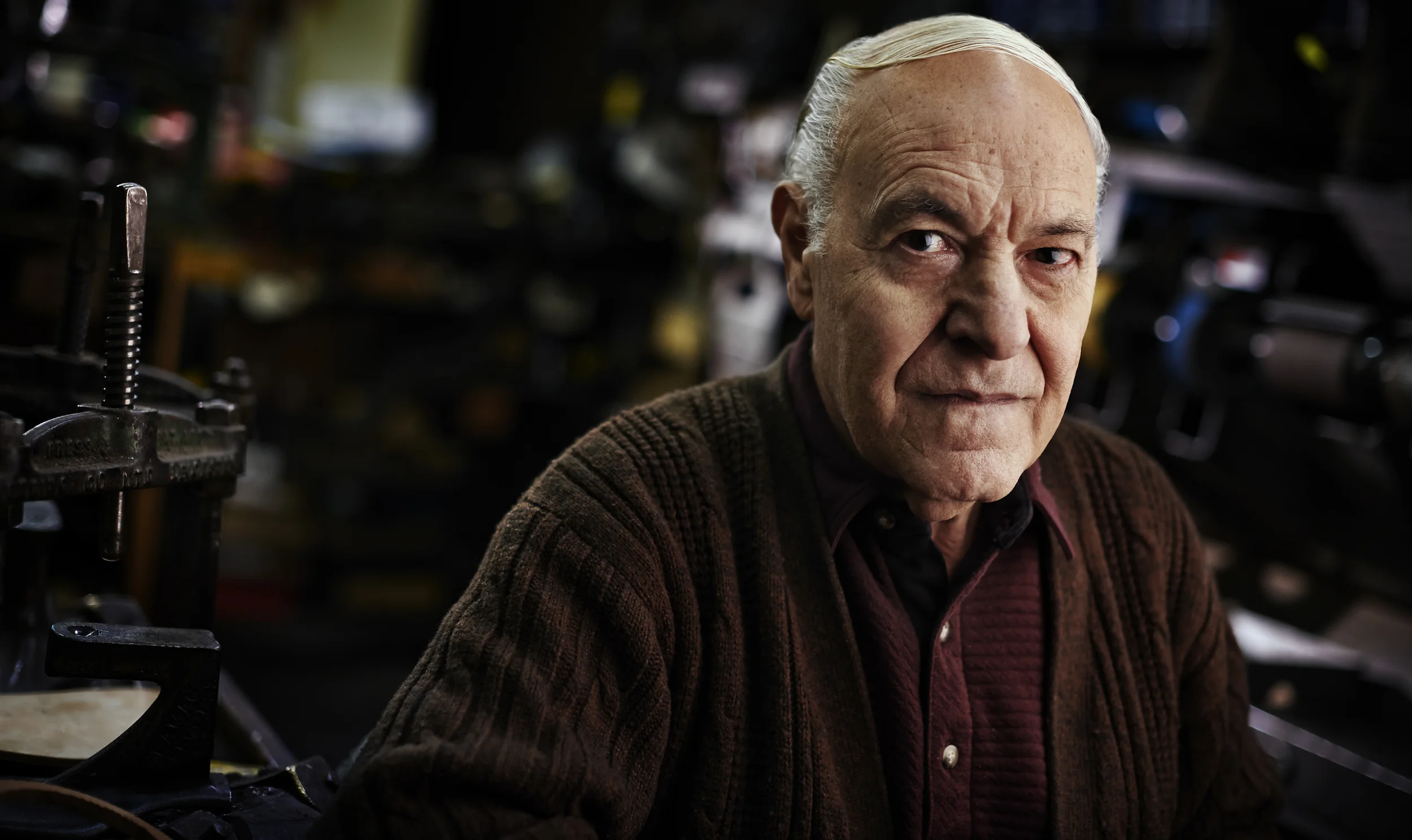

Gene Montemurro page
Gene Montemurro page
Gene Montemurro
“You don’t look neat if your shoes are beat”
Upon opening the doors of Gene’s Shoe Service, you are instantly greeted by the pervasive scent of shoe polish, glue, and leather as you brush past the display windows lined with an eclectic group of restored shoes for sale.
In the front of the store, you can find insoles and the like dangling from hooks fastened to the pegboard wall, as well as a variety of polishes, custom leather belts, and the “largest collection of shoe laces in the United States,” according to the man himself.
Until recently, his wife Mary could be found seated here religiously in one of the five green leather chairs lined up in the reception area, selling purses and leather goods for over 40 years as his trusted assistant.
Gene Montemurro was born in Cleto, Cosenza, Italy on November 9, 1932 to Pasquale and Carmela Montemurro. His father fought in WWI, and then moved to America in 1920. In America, Pasquale, or Patsy as he came to be known, worked with the railroad and then he moved to Arnold, near New Kensington,PA, a bustling blue-collar town thriving along the river from the industries such as Alcoa. Patsy, in fact, was employed by Alcoa, the Aluminum Company of America. His hope was to earn enough money to send for his family to join him.
Gene's mother died in Italy, however, in 1936 before ever moving to America, leaving Gene, at age six and his three brothers in Italy. His older brothers took care of Gene and his younger brother until they could join their father in America. Even though both younger brothers were born American citizens through their naturalized father, immigration was closed during WWII, and they had to wait until after the war to come to the United States.
Gene was 14 years old when he set off to Naples with his younger brother preparing for their voyage to America. Initially, they were not permitted to board the boat because they were minors travelling alone. It was an “act of God” that a certain “Gino from Brooklyn” took responsibility for the two young boys, which allowed for their passage. After fourteen days at sea, the sight of America was “like heaven”, and it was here that Gene met his father for the first time, at Ellis Island in 1947. The three came to the New Kensington-Arnold area.
Gene’s workspace takes up the back end of his store. His Singer sewing machine is an iron workhorse with a manual pedal, a 100 year-old veteran of the Alcoa industry that Gene bought second-hand many years ago. He likes it because “it's heavy and has a long arm.”
His cash register is of vintage stock; a large metal casing decorated with long-stemmed buttons and levers proving its age. Piles of heels, soles, stretchers, shoe molds, and a plethora of oddly shaped tools of the trade litter his workshop as different pieces of machinery for cutting, polishing, sanding and grinding line the perimeter. Mountains of shoes of every color, shape and size engulf him as they wait for his care and attention.
This is truly the place of a lifelong artisan.
Once settled in their new home, Patsy insisted that Gene start learning a trade. Therefore, Gene went to work for a barber in downtown New Kensington.
He made one dollar per week for completing his daily tasks.
This didn’t last long, however, as a local shoe cobbler by the name of Alfonzo Marsico offered Gene three dollars per week to help him fix shoes. This was the incentive that Gene needed to leave the barber and go into the shoe repair business for the rest of his life.
While Gene was apprenticed to the cobbler, he studied English at night school and shined shoes for Mr. Marsico’s son on 11th Street in New Kensington on the weekends. New Kensington was a booming town enjoying the prosperity of post-war America.
City dwellers would wait in lines down the street to get their shoes shined by youths like Gene. Each shoeshine cost fifteen cents, but patrons regularly gave the shoe shiner a quarter to tip for his service.
In two years, Gene saved seven hundred dollars from shoe shining.
When Mr. Marsico closed his shop, Gene went to find work with the cobbler Carl Horvat. Gene approached Mr. Horvat about work, but learned that the established cobbler wasn’t looking to hire; instead, he wanted to retire and sell the shop.
As fate would have it, Mr. Horvat’s asking price?
$700.00
In 1949, Gene opened his first shoe repair shop in New Kensington. Just three years later, he married Mary Jane Palisano, a woman he met at a dance at the Praha Hall in Arnold.
They have two daughters.
Gene has been repairing shoes for over sixty years. He started out as one of thirty-six cobblers in New Kensington in the 1950s, and now he is the only one left in the whole Alle-Kiski area. Therefore, Gene, a master of his trade, is in more demand than ever from his customers.
His biggest reward from the trade comes from his clients and from his ability to help people in the community.
One such example of his passion for helping people is the way in which he customizes “build-up shoes” for those who have difficulty walking or suffer from a debilitating limp. Many clients and doctors only trust Gene for this job.
Gene undertakes every commission with such care and pride, renewing shoes with well-tested remedies, allowing us to wear them in good health for a few more years. Gene repeats an old saying from his shoe shining days,
“You don’t look neat if your shoes are beat.”
At the end of the day, Gene is a craftsman at the finest level, but he is an even better man, husband, grandfather and citizen. He is a true expression of the American dream, one born out of diligence, dignity and honesty, molded by the hands of a cobbler.





